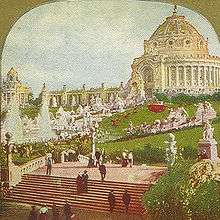St. Louis cuisine
St. Louis cuisine, the food culture of the Greater St. Louis area, has a long history and broad range of influences. The cuisine's influences primarily stem from Italian, German, Irish, and French cuisines, but it includes many American contributions. The cuisine includes unique forms of pizza, barbecue, ravioli, pork, and pastries.
History and composition
St. Louis has a history going back to an early French settlement in 1764,[1] but its cultural styles are seen as centering most significantly around immigrants from Italy, Germany, and Ireland. People from those countries immigrated heavily during the city's significant growth in the nineteenth century. Oktoberfest, sauerkraut, and bratwurst are still popular, as are Irish pubs, and Italian restaurants on The Hill dominate the local culinary topography.
The city was the home of Irma Rombauer, the author of the highly published cookbook The Joy of Cooking.[2]
St. Louis foods
A number of foods are specific to, or known to have originated in St. Louis:[3]
Toasted ravioli

One food that originated in the St. Louis region of The Hill is toasted ravioli, which is a ravioli coated in breading and toasted dry or fried, instead of being boiled or baked wet.
St. Louis-style pizza
St. Louis has a unique and regionally popular variation of pizza known as St. Louis-style pizza. The pizza's traditional characteristics include:
- It is cut in squares ("tavern cut") as opposed to wedges.
- The crust is thin and crisp and is not made with yeast.
- Greater crust strength through square-cutting and crisp crust is needed because the toppings are traditionally arranged in much larger pieces, and are often sliced instead of diced.
- The white processed cheese Provel (composed of provolone, Swiss, and white cheddar) and was originally created because of the low melting point. This allowed for a faster cooking time than other cheeses.
- Its pizza sauce is seasoned with more oregano and less basil than is typical.
Gooey butter cake

Supposedly originating with a botched cake recipe in the 1930s, gooey butter cake and gooey butter cookies are popular in the region. The bottom layer of the cake is flat and dense, made with a box cake mix. The top layer is the "gooey butter" and is made from powdered sugar and cream cheese. The cake is typically dusted with powdered sugar once cooled. Nationally, food enthusiasts largely became aware of the cake when Paula Deen published the recipe in one of her cookbooks.
St. Louis-style BBQ

St. Louis-style barbecue involves direct grilling rather than indirect heat and smoking, as well as a larger volume of the style's sweet, sticky, and acidic tomato-based sauce. It is commonly used with two local meat cuts:
Pork steak
In St. Louis, one of the most common pork dishes is the pork steak, a shoulder cut that is slow-cooked until it becomes very tender, then barbecued.
St. Louis-style ribs
St. Louis-style ribs are spare ribs with the sternum, cartilage and rib tips removed to create a rectangular-shaped rack. The cut of ribs, formally recognized by the USDA as "Pork Ribs, St. Louis Style," supposedly originated with numerous meat-packing plants located in the region in the mid twentieth century.
In past years St. Louis has routinely been named one of the best cities in the country for barbecue.[4]
Slinger
The Slinger is a St. Louis diner food consisting of two eggs, hash browns, and hamburger, steak, or other meat, all covered in chili, onions, and cheddar or American cheese. A variation on this, the Toby, replaces the chili with white gravy.
Gerber sandwich
The Gerber sandwich is an open-faced sandwich, with Italian or French bread, garlic butter, ham, and provel cheese. It is sprinkled with paprika and toasted.
St. Paul sandwich
The St. Paul sandwich originated in St. Louis in the 1940s. It is made with white bread with an egg foo young patty inside, served with dill pickle, white onion, mayonnaise, lettuce, and tomato.
St. Louis World's Fair

The 1904 Louisiana Purchase Exposition, popularly known as the St. Louis World's Fair, is famous for introducing the world to a number of foods that have worldwide popularity today, including:
- Machine-spun cotton candy was invented in 1897 by the dentist William Morrison and confectioner John C. Wharton and first introduced to a wide audience at the 1904 World's Fair as "Fairy Floss"[5] with great success, selling 68,655 boxes at 25¢ per box ($7.12 today[6]).
- Waffle cones were invented when the ice cream stall ran out of bowls from all the customers and the waffle stall had no progress. The waffle guy asked the ice cream man if they could team up. They made waffle cones.
See also
- Cuisine of the Midwestern United States
- Louisiana Purchase Exposition
- Quad City-style pizza
- Horseshoe sandwich
- Red Hot Riplets
References
- ↑ Niderost, Eric. "St. Louis Gateway To The Great Beyond." Wild West 14.1 (2001): 42. MasterFILE Premier. Web. 12 March 2015.
- ↑ Chefs.edu
Provel Cheese, Pork Steaks, and TUMS: St. Louis Food Traditions - ↑ Top Five St. Louis Signature Foods
- ↑ http://www.huffingtonpost.com/hoppercom/americas-ten-best-cities-_b_5106511.html; http://www.foodandwine.com/slideshows/best-bbq-cities#!slide=5
- ↑ "Cotton Candy". The Straight Dope. February 7, 2000. Retrieved November 30, 2011.
- ↑ Federal Reserve Bank of Minneapolis Community Development Project. "Consumer Price Index (estimate) 1800–". Federal Reserve Bank of Minneapolis. Retrieved October 21, 2016.